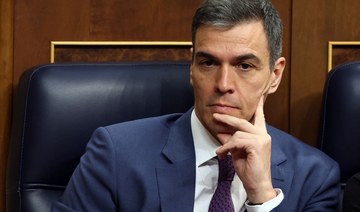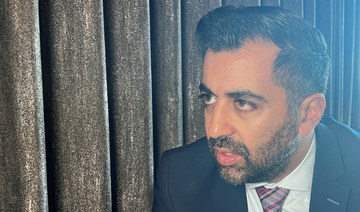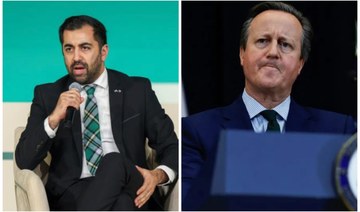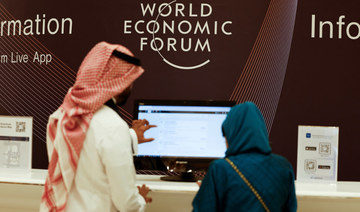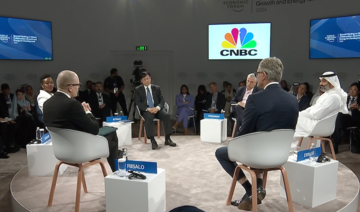MEXICO CITY: Mexican President Enrique Pena Nieto on Thursday called off a meeting with Donald Trump as tensions over the US leader’s vow to make Mexico fund a new wall on the neighbors’ border boiled over.
Trump had been scheduled to receive Pena Nieto at the White House next week, for their first meeting since the inauguration. Instead, the Republican president is facing a foreign policy spat during his first week in the Oval Office.
But their escalating war of words over who would fund the proposed border wall — a central pledge made by Trump during his successful presidential campaign — escalated to the breaking point on Thursday.
“If Mexico is unwilling to pay for the badly needed wall, then it would be better to cancel the upcoming meeting,” Trump said on Twitter in the morning.
The bareknuckle early-morning tweet — already a signature Trump move — shocked diplomats, but was in keeping with the mogul’s hardball approach to negotiations and is likely to delight his supporters. Pena Nieto didn’t take long to rise to the challenge.
“We informed the White House this morning that I will not attend the working meeting scheduled for next Tuesday” with Trump in Washington, the Mexican leader responded on Twitter.
“Mexico reiterates its willingness to work with the United States to reach agreements in both nations’ interests.”
White House spokesman Sean Spicer told reporters that the “lines of communications” would remain open and Washington hoped to “schedule something in the future.”
The first salvos between the two presidents came Wednesday, when Trump ordered officials to begin to “plan, design and construct a physical wall” along the 3,200km US-Mexico border.
Stemming immigration was a central plank of Trump’s election campaign, but he has struggled to articulate how the wall will be paid for, beyond saying “Mexico will pay.”
Republican leaders announced Thursday they would try to carve out $12-15 billion worth of US taxpayers’ money for the project.
Trump’s order had put Pena Nieto under fierce domestic pressure to hit back, and hit back the Mexican leader did in a video message to the nation late Wednesday.
“I regret and condemn the decision of the United States to continue construction of a wall that, for years, has divided us instead of uniting us,” Pena Nieto said.
“I have said it time and again: Mexico will not pay for any wall,” he added.
Around two in three Mexicans have a favorable opinion of the US, according to Pew surveys, but anti-American and anti-Trump sentiment is not uncommon.
Pena Nieto saw his own approval rating slide late last year, after he hosted Trump — then still a White House candidate — in Mexico City.
Trump also took to Twitter on Thursday to gripe about the trade gap between Mexico and the United States.
“The US has a 60 billion dollar trade deficit with Mexico. It has been a one-sided deal from the beginning of NAFTA with massive numbers of jobs and companies lost,” he said.
That deficit for the trade in goods is slightly higher than the overall trade deficit -- including services -- of $49 billion in 2015.
Trump has vowed to renegotiate the 23-year-old North American Free Trade Agreement between Mexico the United States and Canada.
That renegotiation could provide one way for Trump to claim victory, through increased tariffs on Mexican goods or higher border transit costs.
But it could also risk retaliatory tariffs or blowback from US firms who export $267 billion a year south of the border.
Trump has also ordered officials to scour US government departments and agencies in search of “direct and indirect” aid or assistance to the Mexican government and report back within 30 days.
The United States is expected to provide about $134 million worth of assistance to Mexico this year, with much of the spending wrapped up in the “Merida Initiative” to combat drug cartels.
Trump was in Philadelphia on Thursday for a Republican congressional retreat, where he will have to calm some jitters.
While Trump has pursued a solidly conservative governing agenda, his outbursts over inauguration crowd size, his war of words with the media, and revival of his claim of massive voter fraud has led to concerns within his own party.
The Philadelphia meeting will feature another high-profile guest: British Prime Minister Theresa May, who will become the first foreign leader to meet Trump since his inauguration.
May, who addresses the Republican retreat shortly after Trump, will almost certainly discuss the prospects of a key post-Brexit trade deal with the United States.
The two leaders will meet in Washington on Friday and hold a joint news conference, the White House said.
US authorities lack resources to process Haitians quickly enough, leading Mexican authorities to create a ticketing system that leaves them waiting in Tijuana for weeks. Migrant shelters are full, forcing many to sleep on the streets.
Fences and other barriers already blanket about 700 miles of border, much of it in California and Arizona. In San Diego, they helped to virtually shut down what was the busiest corridor for illegal crossings in the 1990s. It’s now one of the most fortified stretches of landscape on the 2,000-mile divide between the two countries.
Border Patrol sector chiefs were asked in November to identify areas where the fence could be expanded, though Trump and his advisers have yet to detail their next steps. Brandon Judd, president of the National Border Patrol Council and a member of Trump’s transition team, supports building a wall in strategic locations and reinforcing existing barriers in certain areas but not where there are natural obstacles, like the Rio Grande river in Texas.
“We do not need a Great Wall of China from California to Texas,” Judd said in an interview last week.
Away from the border, Trump drew support from his base. Tammy Allen, a 52-year-old supporter from Baton Rouge, Louisiana, applauded Trump’s interest in curbing the number of refugees coming to the US and building a wall.
“A lot of countries do. Why not us? Something has got to be done,” she said.
Mexico president cancels Trump talks in US wall row
Mexico president cancels Trump talks in US wall row
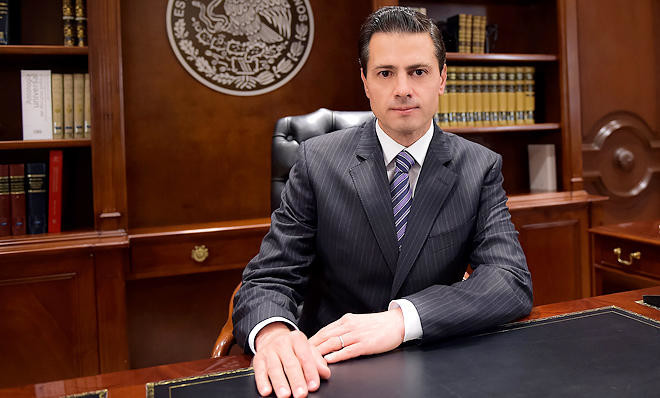
Iran slams crackdown on US student protesters

“The American government has practically ignored its human rights obligations and respect for the principles of democracy that they profess,” foreign ministry spokesman Nasser Kanani said.
Tehran “does not at all accept the violent police and military behavior aimed at the academic atmosphere and student demands,” he said.
American universities have been rocked by pro-Palestinian demonstrations, triggering campus clashes with police and the arrest of some 275 people over the weekend.
The demonstrations began at Columbia University in New York and have since spread across the country.
In Iran, hundreds of people demonstrated in Tehran and other cities on Sunday in solidarity with the US demonstrations.
Some carried banners proclaiming “Death to Israel” and “Gazans are truly oppressed,” state media reported.
The Gaza war broke out after the October 7 attack by Palestinian militants on Israel which killed 1,170 people, mostly civilians, according to Israeli figures.
Tehran backs Hamas, but has denied any direct involvement in the attack.
Israel’s retaliatory offensive against Hamas has since killed at least 34,488 people in Gaza, mostly women and children, according to the Hamas-run territory’s health ministry.
“What we have seen in American universities in recent days is an awakening of the world community and world public opinion toward the Palestinian issue,” Kanani said.
“It is not possible to silence the loud voices of protesters against this crime and genocide through police action and violent policies.”
Pedro Sanchez stays on as Spain’s prime minister after weighing exit
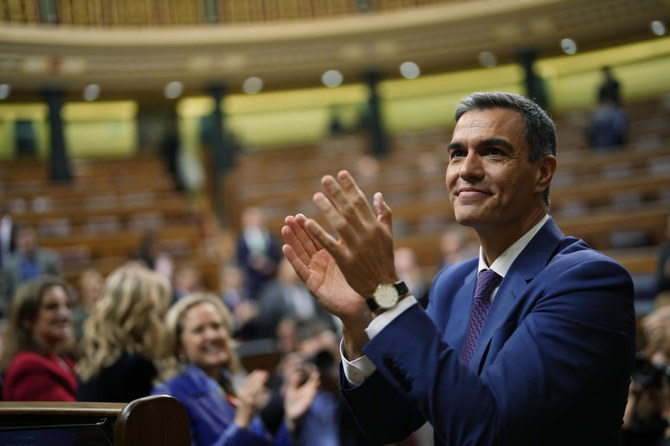
- Sanchez had surprised foes and allies when earlier said he considers quitting
- He described the court investigation of his wife Begona Gomez for influence peddling and business corruption as orchestrated by his opponents
MADRID: Spain’s Prime Minister Pedro Sanchez said on Monday he had decided to continue in office, days after abruptly announcing he was considering his future following the launch of a corruption investigation against his wife.
The center-left prime minister, 52, had surprised foes and allies alike when he said on Wednesday he was taking time from public duty to consider quitting. He described the court investigation of his wife Begona Gomez for influence peddling and business corruption as orchestrated by his opponents.
Sanchez met King Felipe VI on Monday — a step that would have been necessary should he have decided to resign — but announced in a televised address that he had informed the monarch of his decision to stay on. He had been encouraged to stay by widespread expressions of support over the weekend, Sanchez said.
“I have decided to go on, if possible even stronger as prime minister. This is not business as usual, things are going to be different,” he said in a national broadcast.
His announcement that he might quit had caused further turmoil in Spanish politics, where a fractious parliament has struggled to form coalition governments after close elections. Should a new election have been required, it would have been the fourth in five years.
The opposition will try to exploit the sign of indecision from Sanchez, but the impact may be limited because Spain’s political landscape is already so polarized, said Ignacio Jurado, political science professor at Madrid’s Carlos III University.
“His credibility is already hotly contested and voters have already given it to him or taken it away,” he said. “As a leader he has shown a weakness and it’s something that the opposition will exploit a lot.”
Scotland’s Yousaf will resign as first minister, BBC says
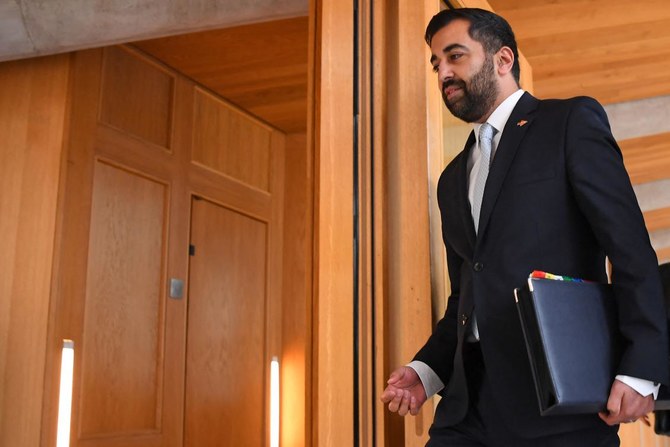
LONDON: Scotland’s first minister Humza Yousaf will resign as early as Monday, the BBC reported, after the possibility of him winning a vote of confidence this week appeared to dwindle over the weekend.
“Scotland’s First Minister Humza Yousaf (is) to resign as early as today, the BBC understands,” BBC News said, without citing a source.
Last week, Yousaf abruptly ended a power-sharing agreement between his Scottish National Party (SNP) and the Green Party, in the hopes that he could lead a minority government — but opposition parties have tabled a vote of no confidence.
The pro-independence SNP’s fortunes have faltered amid a funding scandal and the resignation of a party leader last year, while there has been infighting over how progressive its pitch should be as it seeks to woo back voters.
Just days ago, Yousaf said he was “quite confident” that he could win the no confidence vote called by political opponents, but by Monday, his offer of talks with other parties to try to shore up his minority government seemed to be faltering.
The leadership crisis and a second no-confidence vote against the Scottish government deepens problems faced by Yousaf’s Scottish National Party, which is losing popular support after 17 years of heading the Scottish Government.
Earlier this month, polling firm YouGov said the Labour Party had overtaken the SNP in voting intentions for a Westminster election, for the first time in a decade.
The leader of the Scottish Greens, Patrick Harvie, told BBC radio there was nothing Yousaf could say to persuade his party to support the first minister in the parliamentary confidence vote, leaving Yousaf with few options.
The vote is due to take place later this week.
A victory for Labour in Scotland in Britain’s next national election — expected later this year — would significantly bolster the party’s chances of taking power from Prime Minister Rishi Sunak’s Conservative Party.
If Yousaf loses, parliament would have 28 days to choose a new first minister before an election is forced.
Former SNP leader John Swinney has been approached by senior party figures to become an interim first minister in the event of Yousaf being forced from office, the Times newspaper said, adding that Swinney was reluctant to step up because of personal circumstances.
Yousaf, who previously held health and justice ministerial briefs in the Scottish Government, succeeded former SNP leader Nicola Sturgeon as first minister in March 2023.
She resigned last year and has since been embroiled in a party funding scandal with her husband, who was charged this month with embezzling funds. Both deny wrongdoing.
Global teacher shortage needs more than AI: WEF panelists
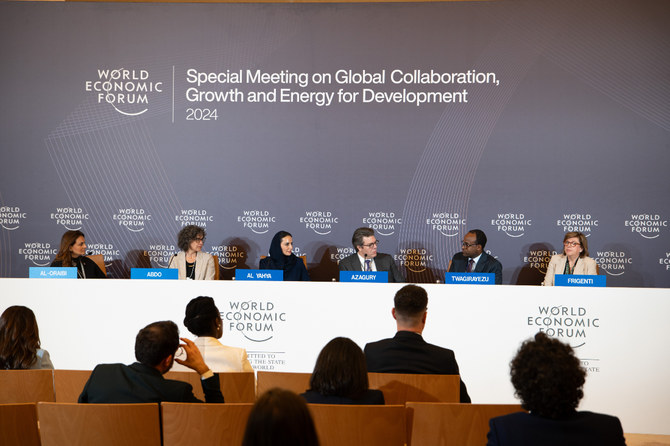
- Tailored solutions required for less-developed nations, says expert
- AI must complement education and training, changing of curricula
RIYADH: The global shortage of teachers will not be remedied solely through the use of artificial intelligence, according to education experts and decision-makers at the World Economic Forum’s Special Meeting in Riyadh.
“Teachers is the biggest problem at the moment for the education sector in low- and middle-income countries,” Laura Frigenti, chief of the Global Partnership for Education platform, told the panel on Sunday.
Gaspard Twagirayezu, Rwanda’s education minister, said that AI can revolutionize education and provide solutions for the global shortage of teachers.
“Of course, AI and technology are not going to replace teachers,” he added. “We can make sure that teachers are properly educated.”
“Here, we are trying to talk about how AI can help in producing education materials for the teachers so that we do not have all these expensive training sessions that we all have to go through.”
Stressing that AI can support teachers in the classroom, Twagirayezu explained that “teachers can be enabled to learn on their own using AI.”
Frigenti said that when it comes to harnessing the power of artificial intelligence in education, “there is not a kind of a one-size-fits-all technology that you can just import into one particular country.”
“You have to start from the conditions of that country and think in terms of a solution,” she continued. If there are no tailored solutions, this would “create a much bigger gap between a part of the world that can invest $8,000 per child per year in education and a part of the world that barely manages to invest $80.”
She added: “And that is going to create all sorts of socio-economic disparities, inequalities within society, (and) inequalities between the Global North and Global South.”
Frigenti added: “We integrate the improvements that technology and AI can add to the way in which the sector performs or is managed to a bigger way of thinking about the sector’s needs to transform, which includes a lot — changing the curricula (and) thinking about what you have to do for the (teachers) problem.”
The panel discussion, titled “Is Education Ready for AI,” featured speakers including Rudayna Abdo, founder and CEO of Thaki; Jack Azagury, group CEO of Accenture; and Deemah Al-Yahya, secretary-general of the Digital Cooperation Organization.
China’s robotic spacecraft headed for moon to carry payload from Pakistan
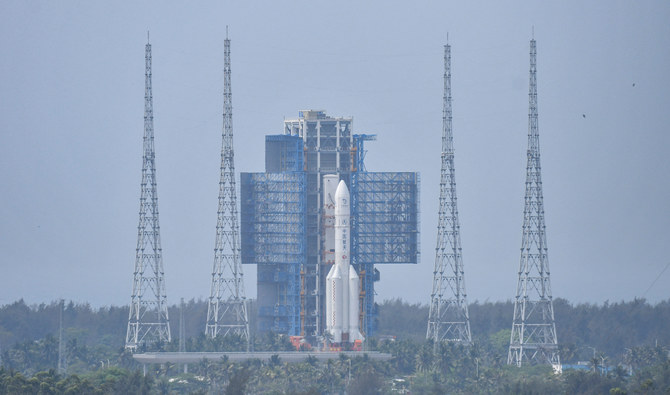
- China will send a robotic spacecraft in coming days on round trip to moon’s far side in first of three missions
- Chang’e-6 spacecraft will carry payloads from countries such as France, Italy, Sweden and Pakistan
BEIJING: China will send a robotic spacecraft in coming days on a round trip to the moon’s far side in the first of three technically demanding missions that will pave the way for an inaugural Chinese crewed landing and a base on the lunar south pole.
Since the first Chang’e mission in 2007, named after the mythical Chinese moon goddess, China has made leaps forward in its lunar exploration, narrowing the technological chasm with the United States and Russia.
In 2020, China brought back samples from the moon’s near side in the first sample retrieval in more than four decades, confirming for the first time it could safely return an uncrewed spacecraft to Earth from the lunar surface.
This week, China is expected to launch Chang’e-6 using the backup spacecraft from the 2020 mission, and collect soil and rocks from the side of the moon that permanently faces away from Earth.
With no direct line of sight with the Earth, Chang’e-6 must rely on a recently deployed relay satellite orbiting the moon during its 53-day mission, including a never-before attempted ascent from the moon’s “hidden” side on its return journey home.
The same relay satellite will support the uncrewed Chang’e-7 and 8 missions in 2026 and 2028, respectively, when China starts to explore the south pole for water and build a rudimentary outpost with Russia. China aims to put its astronauts on the moon by 2030.
Beijing’s polar plans have worried NASA, whose administrator, Bill Nelson, has repeatedly warned that China would claim any water resources as its own. Beijing says it remains committed to cooperation with all nations on building a “shared” future.
On Chang’e-6, China will carry payloads from France, Italy, Sweden and Pakistan, and on Chang’e-7, payloads from Russia, Switzerland and Thailand.
NASA is banned by US law from any collaboration, direct or indirect, with China.
Under the separate NASA-led Artemis program, US astronauts will land near the south pole in 2026, the first humans on the moon since 1972.
“International cooperation is key (to lunar exploration),” Clive Neal, professor of planetary geology at the University of Notre Dame, told Reuters. “It’s just that China and the US aren’t cooperating right now. I hope that will happen.”
SOUTH POLE AMBITIONS
Chang’e 6 will attempt to land on the northeastern side of the vast South Pole-Aitkin Basin, the oldest known impact crater in the solar system.
The southernmost landing ever was carried out in February by IM-1, a joint mission between NASA and the Texas-based private firm Intuitive Machines.
After touchdown at Malapert A, a site near the south pole that was believed to be relatively flat, the spacecraft tilted sharply to one side amid a host of technical problems, reflecting the high-risk nature of lunar landings.
The south pole has been described by scientists as the “golden belt” for lunar exploration.
Polar ice could sustain long-term research bases without relying on expensive resources transported from Earth. India’s Chandrayaan-1 launched in 2008 confirmed the existence of ice inside polar craters.
Chang’e-6’s sample return could also shed more light on the early evolution of the moon and the inner solar system.
The lack of volcanic activity on the moon’s far side means there are more craters not covered by ancient lava flows, preserving materials from the moon’s early formation.
So far, all lunar samples taken by the United States and the former Soviet Union in the 1970s and China in 2020 were from the moon’s near side, where volcanism had been far more active.
Chang’e-6, after a successful landing, will collect about 2 kilograms (4.4 pounds) of samples with a mechanical scoop and a drill.
“If successful, China’s Chang’e-6 mission would be a milestone-making event,” Leonard David, author of “Moon Rush: The New Space Race,” told Reuters. “The robotic reach to the Moon’s far side, and bringing specimens back to Earth, helps fill in the blanks about the still-murky origin of our Moon.”


